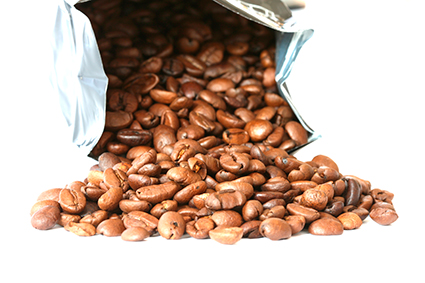Modified Atmosphere Packaging of Coffee

As the demand for premium quality coffee continues to increase around the world, manufacturers must ensure that their product remains fresh for as long as possible. For freshly roasted coffee, oxygen is the number one enemy. As soon as coffee beans have been roasted, the volatile oils that are responsible for coffee’s alluring aromas and flavours are vulnerable to oxidation by oxygen in the air.
One approach that manufacturers use is to package the freshly roasted beans in a metallic foil bag containing a valve. Freshly roasted coffee beans give out carbon dioxide for several hours after roasting, and because this is heavier than oxygen it can push the oxygen upwards towards the top of the packaging and out of the valve.
This can bring the oxygen content of the package down, but the extent of the displacement of the oxygen depends largely how long after roasting the bag is sealed. Even if the levels come down to, for example, 5 or 10 per cent this concentration of oxygen is still sufficient to cause significant oxidation of the volatile oils of the beans. Tests have shown that it is best to have less than 3 per cent oxygen in the package.
An efficient way of achieving this is to flush the package with the inert gas nitrogen to displace nearly all of the oxygen. This gives the coffee a much longer shelf life, retaining the distinctive aromas and flavours. The nitrogen itself can be supplied in cylinders for smaller producers, with bulk tanks or even on-site generation for larger producers.
With oxygen almost completely expelled from the package, the volatiles remain unoxidised for far longer – allowing the coffee to maintain its freshness and achieve a significantly prolonged shelf life.
The value of flushing fresh coffee with nitrogen is illustrated by this comment from the Coffeed website for coffee lovers (www.coffeed.com):
“We have found that nitro flushing does in fact prolong and stabilise coffee. In simple taste tests, comparing nitro-flushed coffee, to non-nitro (valve bag) coffee, the results are significantly different. When we shipped our nitro flushed bag for testing the residual O2 levels were less than 1.5%. While we did not ship comparative bags of non-flushed bags for testing, the proof was in the pudding, or in the cup. After 24 days, the espresso was awesome when pulled from the nitro flushed bag, but flat and baggy when pulled from an ordinary, one-way valve bag.”
When flushing packages of freshly roasted coffee with nitrogen, it is important to ensure that the correct gas mixture has entered the bag and that the residual oxygen concentration is at an appropriately low level. Dansensor, a leading manufacturer of precision instrumentation for modified atmosphere packaging (MAP), supplies products to enable coffee packagers to achieve this goal.
An on-line gas analyser, such as Dansensor’s MAP Check 3, allows continuous monitoring of the gas mixture entering the packaging chamber to ensure that residual oxygen does not exceed a pre-determined concentration. Alternatively, a headspace analyser, such as Dansensor’s CheckMate 3 or CheckPoint II, permits measurements of oxygen levels within selected packages after they have been sealed, providing the producer with a rapid and accurate quality assurance method to ensure that packages are receiving the correct mixture.
Please click here to read more about Modified Atmosphere Packaging of coffee.




